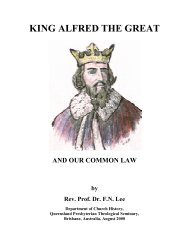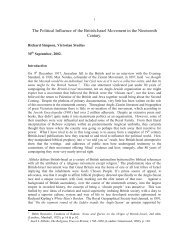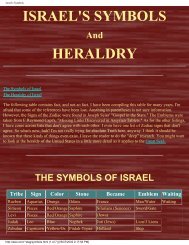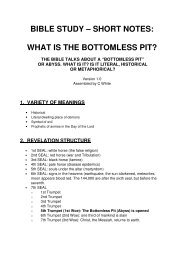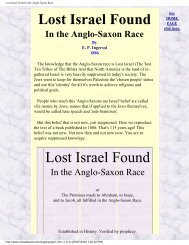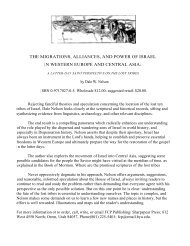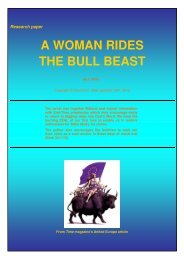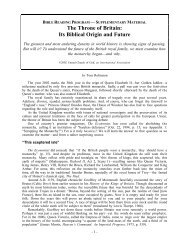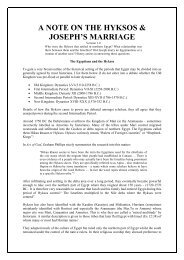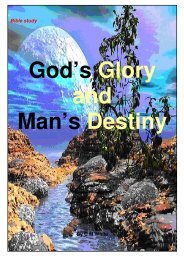CH. 6. COMMON LAW AMONG THE ANCIENT ... - Origin of Nations
CH. 6. COMMON LAW AMONG THE ANCIENT ... - Origin of Nations
CH. 6. COMMON LAW AMONG THE ANCIENT ... - Origin of Nations
Create successful ePaper yourself
Turn your PDF publications into a flip-book with our unique Google optimized e-Paper software.
native system till the age <strong>of</strong> the Vikings -- though the influence <strong>of</strong> Christianity should notbe discounted.In Ireland, a large number <strong>of</strong> ancient law tracts was preserved. Many <strong>of</strong> these go back toearly times. The Irish laws are probably the oldest surviving in Europe -- unaffected byRoman Law and the customs <strong>of</strong> the Mediterranean countries. The really ancient Irishcommunities served some <strong>of</strong> the functions <strong>of</strong> towns proper; being used as meeting-places,markets, or the like.An oenach or fair seems to have been attached to each true town <strong>of</strong> whatever size.Larger centres, such as Tell-town and Tara, held large annual fairs. Below the king,society was divided into three principal classes -- similar to the druides [or judges], theequites [or knights] and the plebs [or people] <strong>of</strong> Julius Caesar's Gaul. There were alsothe warrior aristocracy; the landowners; and the patrons <strong>of</strong> the arts. Such corresponded tothe equites.Of comparable social status were what we might terms the intelligentsia -- the aes dania[or pr<strong>of</strong>essionals] who in Pre-Christian times and later included not only the druids butalso the bards, the jurists, the physicians, the historians, the artists and the craftsmen. Thethird class -- the equivalent <strong>of</strong> the plebs -- comprised the body <strong>of</strong> freemen, commoners,and peasants who formed the basis <strong>of</strong> society.The obligations and rights <strong>of</strong> each freeman within a Tuath or individual State, weredefined clearly and enforced by Customary Law. In Pre-Christian times, an importantfactor may very well have been the threat wielded by the druids -- the threat <strong>of</strong> virtuallyoutlawing a transgressor.In general, it appears that parties to legal disputes agreed in advance to accept the rules <strong>of</strong>the brithem alias the pr<strong>of</strong>essional jurists. The surviving legal codes show clearly thatmost causes <strong>of</strong> dispute from murder downwards were provided with means <strong>of</strong> redress notby imprisonment but by some form <strong>of</strong> log n-erech or 'honour price.'The most striking feature <strong>of</strong> the native institutions <strong>of</strong> Ireland, is its system <strong>of</strong> fines. InIrish systems, privilege and responsibilities alike rested on the kindred -- which extendedfor four generations. Thus Pr<strong>of</strong>essor Chadwick. Cf. Exodus 20:5; 21:22; 22:1.In Ireland, case laws were recorded in treatises written by jurists called brehons. By thetime <strong>of</strong> Christ's incarnation, maintains K. Neill,#185# the ancient law tracts distinguishedbetween no less than twenty-seven distinct classes <strong>of</strong> freemen. Yet rank depended onwealth as well as birth. It was possible to rise or fall in status -- depending upon one'stalents.The land-owning class was the foundation <strong>of</strong> Celtic society. The farmer <strong>of</strong> this periodwas called a boaire. He was, literally, a 'cattle man.'The Celtic legal tradition was very specific. It provided exact compensations for50




